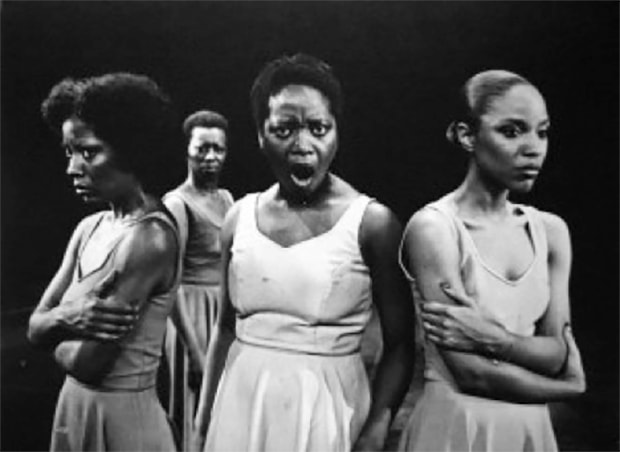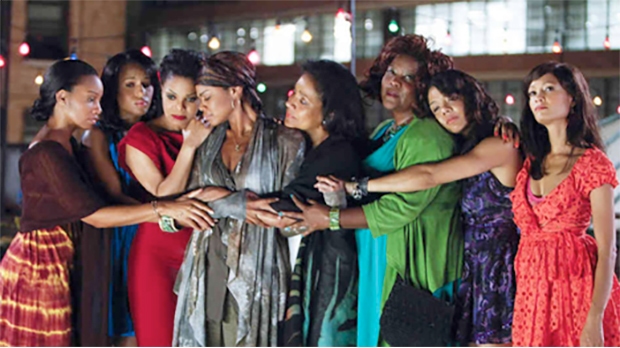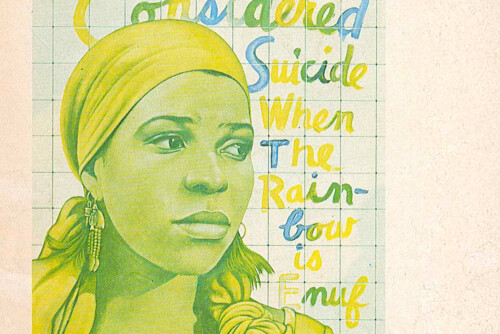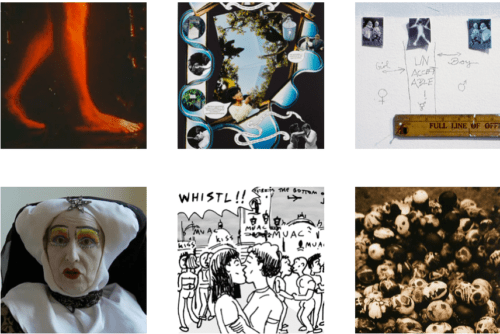“dark phrases,” the first poem in for colored girls, introduces an imperative—“somebody/ anybody / sing a black girl’s song”—as it establishes a context for the absence of the black girl’s story. Lady in brown laments, “dark phrases of womanhood / of never havin been a girl” in order to introduce “the predominant perceptions of black women and the historical uses of their labor,” which, according to Aliyyah I. Abdur-Rahman, “have brought black motherhood and black girlhood into such unbearable and convoluted proximity that their differences eventually bottom out.”1 The lack of innocence, premature aging, and experience of having never been a girl that suggest an accelerated sexual maturation resulting from black women’s dominance and exploitation through rape, violence, and poverty—ideas which were reaffirmed in 2013 with the sexualized slur hurled at Oscar-nominated child actor Quvenzhané Wallis by The Onion—are issues that are explored in detail throughout the choreopoem. The reclamation of black girlhood functions not only to confer innocence, but also to clear space for black women to function as desiring, erotic, and sensual subjects. The predominant perception of black women as overtly sexual not only bars black girls from girlhood but also imbricates desire in the production of race.
Lady in brown’s opening line does not produce a traditional familial relationship but creates an intergenerational one, establishing how communal ties may develop in addition to heteronormative familial structures. From the opening line of the dramatic text, for colored girls troubles national fantasies of men protecting girls as they mature into women. Black women have long been blamed for the black family’s inability to approximate the ideal of the nuclear family, and while it is not the purpose of this essay to rehash those histories, which often begin with an investigation of the notorious Moynihan Report, I would like to establish the historical context as a point of departure in Shange’s work. The choreopoem is situated between the black nationalist desires of the Black Arts Movement and the black feminist longing of the black women writers’ renaissance.
The opening lines of the choreopoem establish the production of social roles as central to the story that will be told, insofar as the other characters respond to the lady in brown’s call through a reclamation of black girlhood in the form of singing familiar children’s songs. According to black feminist critic Cheryl Wall, quoting Hortense Spillers:
“Family,” as we practice and understand it “in the West”—the vertical transfer of a bloodline, of patronymic, of titles and entitlements, of real estate and the prerogatives of “cold cash,” from fathers to sons and in the supposedly free exchange of affectional ties between a male and female of his choices—“becomes the mythically revered privilege of a free and freed community.” Bereft of this “privilege,” African American families historically assume configurations for which the dominant order has no category. In contrast to most public discourses however, in black women’s writing these configurations, like Morrison’s three-woman households, do not necessarily become a cause of despair but a site of possibility.2
In “dark phrases” the choreopoem introduces a history of discursive practices that alienate black women. She asserts:
this must be the spook house
another song with no singers
lyrics / no voices& interrupted solos
unseen performancesare we ghouls?
children of horror?
the joke?
Providing a solution to the depiction of black women as the source of national degeneration, the play scripts lady in brown moving from being the only speaker onstage to being joined by a chorus of other voices.
for colored girls stages collectivity, which functions alongside Toni Morrison’s three-woman households as nonpatriarchal sites of black living and becoming. The alternative forms of kinship that Shange and Morrison provide advance a black feminist sensibility central to the black women writers’ renaissance. As Susana M. Morris argues in Close Kin and Distant Relatives, “Black women writers advocate a fundamental reimagining of kinship to include examples of extended and fictive kin (as opposed to making the nuclear family the only legitimate model), platonic unions . . . and queer families.”3 Lady in brown draws the other characters to the stage and they begin to sing children’s rhymes and play youthful games to reclaim the girl within and offer a woman-centered vision of collectivity. The choreography and storytelling allows the actors to enter into a social script that does not presume their degeneracy, as it introduces the audience to black women flourishing across generations without the mandate of a genetic connection. It also suggests how social scripts function to produce ideals and work in relationship to embodied movement and narrative.
While my interpretation of for colored girls emphasizes the ability to create community across bloodless lines of transfer, the two film adaptations of the play offer opening sequences that shift the dynamic of moving from a singular to collective communal voice scripted in the dramatic text. The American Playhouse made-for-television movie (1982) of the play begins with Pattie LaBelle singing “dark phrases” and then moves to Shange questioning her ability to communicate the stories of the women in her family to her daughter Savannah. The scene ends with Shange holding her daughter. In Tyler Perry’s 2009 adaptation, the voices of the actresses in the film merge together to recite “dark phrases.” As a medium, film is more readily accessible than live theater and therefore has the potential to reach a larger audience than a single theatrical production. Therefore a scholarly examination of the dramatic work, either in writing or discussion, cannot ignore the 1982 and 2009 film adaptations as acts of interpretation that have greatly informed reception. My contention, however, is that Shange’s drama functions not only as a cultural object but also as a scriptive thing that calls forth relationships in live theatrical production. The filmic adaptations must be understood in relationship to but not in replacement of the choreopoem as a formal device enacted in live performance. My interpretation also aligns for colored girls with depictions of collectivity in the work of Shange’s contemporary black women writers.
Shange notes that the transformation of for colored girls from a set of poems to a choreopoem happened as a result of actors taking on her words and embodying her characters. She explains, “I was suddenly surrounded by a circle of women, sacred in construction. My solo voice began its journey to many voices.”4 The movement from a single voice to a multitude of voices marks a transition central to the choreopoem as a feminist and visionary project that connects women based on their shared experience instead of their reproductive labor, amounting to chosen families instead of required ones.
In “dark phrases” Shange stages a history of black womanhood based on loving play. Slapping and holding hands, singing and dancing, the ladies in brown, yellow, purple, red, green, blue, and orange reclaim black girlhood. In for colored girls, touch oscillates from intimacy to violence, demonstrating the way that physical interaction reproduces modes of sociality. In Lost in Language and Sound, Shange contends that understanding the black body attenuates the strength of narratives that turn black women into monstrosities. She explains, “With the acceptance of the ethnicity of my thighs & backside came a clearer understanding of my voice as a woman & as a poet. The freedom to move in space, to demand of my own sweat a perfection that could continually be approached, though never known, waz poem to me, my body & mind ellipsing, possibly for the first time in my life.”5 Rather than trying to assimilate into a system of desire that diminishes the shape of the black woman, Shange suggests that in order to find her voice she needed to accept her body. Dance was part of the process of moving toward acceptance.
Physical reproduction functions through touch, as do many disciplinary practices. The choreopoem first introduces the nurturing quality of touch in order to offer a mechanism to alleviate the sting of bodily violations, which affect black women disproportionately, including rape and domestic violence. The touching in “dark phrases” also has its own reproductive potential because it cultivates intergenerational relationships. While touch has the ability to signify sexual histories, according to Sharon Holland, via a reading of Jacques Derrida:
Both physical and psychic, touch is an act that can embody multiple, conflicting agendas. It can be both a troubled and troublesome component in the relationship between intimates, as in the case of Derrida; or, alternatively, the touch can alter the very idea as well as the actuality of relationships, morphing friends into enemies and strangers into intimates. For touch can encompass empathy as well as violation, passivity as well as active aggression. It can be safely dangerous, or dangerously safe. It also carries a message about the immediate present, the possible future, and the problematic past. Finally, touch crosses boundaries, in fact and imagination.6
Through touching, teasing, and playing in the opening scene, for colored girls creates connections among women and recoups a past in order to prepare the characters to express their individual stories and come together at the end of the dramatic work through a laying on of hands.
The choreopoem is bookended with poems, pieces that emphasize the interweaving of scripted movement and poetics. The voices that emerge in the poems depend on positioning the body in certain spaces and in relationship to other bodies—choreography. According to dance scholar André Lepecki, choreography is “a technology that creates a body disciplined to move according to the commands of writing.”7 Shange’s dramatic text manipulates the poetic form “using a shortened form of spelling and a typography that juxtaposes fragmented elements to emphasize shifts in the tone and intensity of the language. Shange’s poetic language manifests the sounds and rhythms of African American speech,” and therefore issues a culturally specific command to the performance.8 Poetics as an expressive practice exceeds the singularity of the written that Lepecki describes. The poetic speech acts creates a rhythm that coincides with the movement of the bodies and the creation of community through touch and shared space. The structure of the speech acts in poetics has a performative function that facilitates the black female collectivity central to the choreopoem.
In addition, for colored girls scripts movements, and through “choreography creates its process of subjectification.”9 The hybrid form of the choreopoem calls forth black female subjectivity as practices that constantly negotiate their own limits insofar as the choreopoem functions as a doing and as a thing done. The final piece, “a layin on of hands,” enacts a ritualized mode of performance that draws from spiritual practices and allows women to connect physically and on equal ground. The engagement of touch and speech offers a way to appreciate communal belonging that affirms black women’s humanity. Lady in purple specifies, “not my mama/ holdin me tight/ sayin / i’m always gonna be her girl / not a layin on of bosom & womb / a layin on of hands / the holiness of myself released.”10 Affirming a mode of reproductive futurity that requires not an intergenerational transfer from mother to child but a coming together among women, this sociality depends on “the touch, crossing boundaries,” which “affirms the inadequacy of this boundary between selves.”11
As I have shown, the choreopoem depicts black feminist collectivity in the dramatic text, which actors recreate in each staging of the drama. In a 2010 production of the play at Tufts University, Monica White Ndounou, the director and a member of the New England Black Scholars Collective (of which I am also a member), transformed the theater space by using a lynching rope, which communicated the devaluation of the black body in the opening scene, and which transformed into a jump rope by the end of the scene. The two actors turning the rope connect through an object they transform into a mechanism of play. The transfer from actor to object back to actor again creates a circuit of bloodless becoming that also remembers the blood loss the lynch rope enacts. The object of persecution becomes a mechanism of remembrance, joy, and play.
As Ndounou suggests in this video clip, the play offers a remedy to the alienating characterization of black women through the fantasy of black female collectivity. In lingering for a moment with Ndounou’s production, I seek to call attention to how her practice informs my own work and how the work of our collective resonates with that of another “group of Boston-based black feminists,” the Combahee River Collective, who are invested in seeing the world differently and creating sites for their irreverent, improbable, and therefore powerful visions.12 According to Berlant, “Fantasy is the means by which people hoard idealizing theories and tableaux about how they and the world ‘add up to something.”13 Fantasies do not merely function as amorphous, inconsequential longing. They organize the logics of desire that produce value and values. Many cultural wars have been waged in the name of the family and its values, even though the nuclear family remains a fantasy for the majority of Americans.14
for colored girls demonstrates the process of producing an alternative ideal as it offers audiences an object of desire. “Circuits of desire are particularly meaningful in the African American context because desirability, both in social and political contexts and in cultural production, is a crucial part of ascribing individual and communal value to blackness.”15 The choreopoem is not only aspirational in that in carves out physical space on the stage for connection and psychic space to imagine alternative modes of intergenerational transfer, it also presents black women as desirable and desiring subjects. In depathologizing black women’s desire through the communal-forming practice of touch, the choreopoem reclaims black women’s bodies and affirms black women’s voices. Consider how the erotic pull of “graduation nite” and “sechita,” and the reclamation of desire in “no assistance,” “no more love poems #1,” “no more love poems #2,” “no more love poems #3,” “no more love poems #4,” “somebody almost walked off wid all my stuff,” and “sorry” position black women as implicitly valuable and also as arbiters of value.

My final comments appeared alongside a blank frame during my oral presentation of this essay because in concluding, I venture to make a gesture that riffs on Morrison’s acknowledgement of the reader’s participatory role in the crafting of narrative. In her Nobel lecture and in the final lines of Jazz, Morrison reminds the audience that meaning-making is in your hands. Similarly, the haptic experience that for colored girls enacts enables a bloodless form of transfer that leads to the possibility of collective world-making. Participating in the value and valuing of black feminist collectivity does not end in theoretical examination or theatrical production. In fact, what is sustaining about for colored girls as a choreopoem is that it requires students and scholars to engage with body and voice in studying the play.

The collaboration of voices and bodies come together to communicate a common experience that affirms the danger of lady in brown’s singular voice at the beginning of the play and the necessity of collectivity, whether in the classroom or in a scholarly community. “The poems,” in Shange’s words, “introduce the girls to other kinds of people of color, other worlds. To adventure, and kindness, and cruelty. Cruelty that we usually think we face, alone, but we don’t. We discover that by sharing with each other we find strength to go on.”4 The laying on of hands communicates connection, solidarity, and commitment as it reiterates a process that one engages with when reading and studying the play. It also follows the disruption of biological inheritance as depicted in filicide central to the penultimate poem “a nite with beau willie brown.” The laying on of hands in the final scene offers a model of healing the rupture of family ties enacted through the severing of maternal rights in the previous poem. But as Hortense Spillers explicates in “Mama’s Baby, Papa’s Maybe: An American Grammar Book,” the black woman’s peculiar relationship to the United States of America depends on a tenuous relationship to biological modes of kinship, but that relationship must not determine her claim to national belonging. As lady in brown instructs, the emergence of an alternative national filial relationship requires the audience’s participation. She entreats, “let her be born / let her be born / & handled warmly.”16 The handling does not begin or end in production but continues through the turning of the page, the thoughtful engagement of the reader, and the world-making she chooses to endeavor toward enacting.
Acknowledgements: Many thanks to Kim F. Hall, Monica L. Miller, and Yvette Christianse for inviting me to take part in the Worlds of Ntozake Shange Conference and the yearlong events to celebrate Shange and the twentieth anniversary of Africana Studies at Barnard College. I am also thankful for the feedback I received from the members of the New England Black Scholars Collective as I revised the essay, and the challenge to be a fearless scholar and teacher posed by the students in my Black Theater USA class at Dartmouth College in the fall semester of 2012.
- Aliyyah Abdur-Rahman, Against the Closet: Black Political Longing and the Erotics of Race (Durham: Duke UP, 2012) 17. [↩]
- Cheryl Wall, Worrying the Line: Black Women Writers, Lineage, and Literary Tradition (Chapel Hill: U of North Carolina P, 2005) 10-11. [↩]
- Susana M. Morris, Close Kin and Distant Relatives: The Paradox of Respectability in Black Women’s Literature (Charlottesville: U of Virginia P, 2014). [↩]
- Shange, for colored girls 2010: 3. [↩] [↩]
- Ntozake Shange, Lost in Language and Sound: or How I found My Way to the Arts: Essays (New York: St, Martin’s, 2011) 8. [↩]
- Sharon Patricia Holland, The Erotic Life of Racism (Durham: Duke UP, 2012) 100. [↩]
- André Lepecki, Exhausting Dance: Performance and the Politics of Movement (New York: Routledge, 2006) 6. [↩]
- Gwen Raaberg, “Beyond Fragmentation: Collage as Feminist Strategy in the Arts,” Mosaic: A Journal for the Interdisciplinary Study of Literature 31.3 (1998): 153-171. Accessed online 7 April 2013, paragraph 18. Available at http://search.proquest.com/docview/205369107#. [↩]
- Lepecki, Exhausting Dance 6. [↩]
- Shange, for colored girls 2010: 86. [↩]
- Holland, The Erotic Life of Racism 101. [↩]
- Farah Jasmine Griffin, “That Mothers May Soar and the Daughters May Know Their Names: A Retrospective of Black Feminist Literary Criticism” Signs 32.2 (2007): 489. [↩]
- Berlant, Cruel Optimism 2. [↩]
- See http://www.nytimes.com/2001/05/18/opinion/the-changing-american-family.html. [↩]
- Abdur-Rahman, Against the Closet 15. [↩]
- Shange, for colored girls 2010: 19. [↩]




